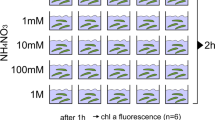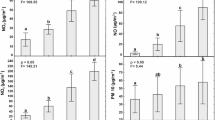Abstract
Four lichen species, Parmelia sulcata Taylor, Hypogymnia physodes (L.) Nyl., Cetraria islandica (L.)Ach., and Bryoria fuscescens (Gyelnik) Brodo andHawksworth were exposed during autumn and winter at differentsites of the Erzgebirge (Ore Mountains), the Fichtelgebirge andcontrol sites. All lichens tested became visibly damaged withtime. Thallus bleaching started from the edges and went on tothe centre of the thallus. Sites of facilitated gas exchangelike the soralia of P. sulcata and the pseudocyphelles ofC. islandica became preferentially bleached. The sulfateconcentration increased with exposure time reaching 200% ofunpolluted controls. In contrast to coniferous trees (e.g. Picea abies), further exposure lead to a reduction in the S-concentration in the lichens, as sulfate and otherintracellular metabolites were leached from the thalli due tomembrane damage. The changes in the K-concentration proved tobe an excellent measure for membrane leakiness; it wascorrelated with time of exposure and with SO2 concentrations at the different sites. Photosynthetic capacityand respiration were also strongly affected. Depending on theSO2-dose, the Bryoria species were unable tophotosynthesize as early as 4–8 weeks after exposure, whereasCetraria and Hypogymnia showed clear reduction intheir ability to photoreduce CO2 within 8–10 weeks ofexposure in the field. Parmelia sulcata was found to bethe most tolerant species. After 3–4 months, photosynthesis wasreduced by only 30%. The bioindicative value of theseobservations is discussed.
Similar content being viewed by others
References
von Arb, C. and Brunold, C.: 1990, Can. J. Bot. 68, 35.
Bachmann, E.: 1914, Hedwigia 55, 157.
Baddeley, M. S., Ferry, B. W. and Finegan, E. J.: 1973, ‘Sulphur Dioxide and Air Pollution in Lichens’, in B.W. Ferry, M. S. Baddeley and D. L. Hawksworth (eds.), Air Pollution and Lichens, London, pp. 299–313.
Börtitz, S. and Ranft, H.: 1972, Biol. Zbl. 91, 613.
Dässler, H. G. and Ranft, H.: 1969, Flora 158, 454.
Doll, R. and Ziebold, A.: 1976, Biol. Rundschau 14, 78.
Eversmann, S.: 1978, Bryologist 81, 368.
Farrar, J. F.: 1976, New Phytologist 77, 93.
Feige, G. B.: 1982, Decheniana Beihefte 26, 23.
Flemming, G.: 1964, Wiss. Z. Techn. Univ. Dresden 13, 1531.
Flössner, W.: 1963, ‘Beiträge zur Flechtenflora des Erzgebirges im Raum zwischen FreibergerMulde und Preßnitz’, Veröff. d. Museum f. Naturk., Karl-Marx-Stadt, Heft 2.
Gasch, G., Grünhage, L., Jäger, H.-J. and Wentzel, K.-F.: 1988, Angew. Bot. 62, 73.
Gilbert, O. L.: 1970, New Phytol. 69, 629.
Gilbert, O. L.: 1973, ‘Lichens and Air Pollution’, in V. Ahmadjian and M. E. Hale (eds.), The lichens, CRC Press, NY, pp. 443–472.
Gilmore, A. M. and Yamamoto, H. Y.: 1991, J. Chrom. 543, 137.
Grace, B., Gillespie T. J. and Puckett, K. J.: 1985, Can. J. Bot. 63, 797.
Guderian, R., Küppers, K. and Six, R.: 1985, ‘Wirkungen von Ozon, Schwefeldioxid und Stickstoffdioxid auf Fichte und Pappel bei unterschiedlicher Versorgung mit Magnesium und Kalzium sowie auf die Blattflechte Hypogymnia physodes’, VDI-Berichte, Nr. 560, pp. 657–701.
Hällgren, J.-E. and Huss, K: 1975, Physiol. Plant 34, 171.
Hawksworth, D. L. and Rose, F.: 1970, Nature (London) 227, 145.
Hawksworth, D. L. and Rose, F.: 1976, Lichens as Pollution Monitors, Studies in Biology No. 66, Edward Arnold, London.
Knabe, W.: 1983, ‘Immissionsökologische Waldzustandserfassung’, in Mitt LÖLF, Sonderheft Immissionsbelastungen von Waldökosystemen, pp. 43–57.
Krouse, H. R.: 1977, Nature (London) 265, 45.
Laundon, J. R.: 1973, ‘Urban Lichen Studies’, in B.W. Ferry, M. S. Baddeley and D. L. Hawksworth (eds.), Air Pollution and Lichens, The Athlone Press, pp. 109–123.
Lufthygienische Monatsberichte: 1993–1994, Bayerisches Landesamt für Umweltschutz, München.
Marti, J.: 1983, Can. J. Bot. 61, 1647.
Masuch, G.: 1993, Biologie der Flechten, Quelle & Meyer, Heidelberg, Wiesbaden, 411 pp.
Miszalski, Z. and Niewiadomska, E.: 1993, New Phytol. 123, 345.
Nash, T. H. and Gries, C.: 1991, ‘Lichens as Indicators of Air Pollution’, in O. Hutzinger (ed.), The Handbook of Environmental Chemistry 4C, Springer Berlin, NY, pp. 2–29.
Nylander, W.: 1866, Bull. Soc. Bot. Fr. 13, 364.
Pearson, L. C.: 1985, Atmos. Environ. 19, 209.
Pearson, L. C. and Henriksson, L.: 1981, The Bryologist 84(4), 515.
Pearson, L. C. and Rodgers, G. A.: 1982, Phyton 22, 329.
Peiser, G. D., Lizada M. C. C. and Yang, S. F.: 1982, Plant Physiol. 70, 994.
Pfanz, H. and Beyschlag, W.: 1993, Trees 7, 115.
Pfanz, H. and Vollrath, B.: 1993, ‘Photosynthese und Nährstoffgehalte von Buchen unterschiedlich stark SO2-belasteter Standorte’, in K. E. Rehfuess and H. Ziegler (eds.), Zustand und Gefährdung der Laubwälder, Rundgespr. Komm. Ökologie Bd. 5, Dr. Pfeil Verlag, München, pp. 129–142.
Puckett, K. J., Tomassini, F. D., Nieboer, E. and Richardson, D. H. S.: 1974, New Phytol. 79, 135.
Ronen, R. and Galun, M.: 1984, Env. Exp. Bot. 24(3), 239.
Roy, A. B. and Trudinger, P. A.: 1970, The Biochemistry of Inorganic Compounds of Sulphur, Cambridge Univ. Press, London.
Schramel, P.: 1988, Spectrochim. Acta 43B, 881.
Schumm, F. and Kreeb, K. H.: 1979, Angew. Bot. 53, 31.
Sekiya, J., Wilson, L. G. and Filner, P.: 1982, Plant Physiol. 70, 437.
Sigal, L. L. and Nash, T. H.: 1983, Ecology 64, 1343.
Skye, E.: 1979, Annu. Rev. Plant Phytopathol. 17, 325.
Takala, K., Olkkonen, H., Ikonen, J., Jääskeläinen, J. and Puumalainen, P.: 1985, Ann. Bot. Fennici. 22, 91.
Türk, R., Wirth, V. and Lange, O. L.: 1974, Oecologia 15, 33.
Author information
Authors and Affiliations
Rights and permissions
About this article
Cite this article
Häffner, E., Lomský, B., Hynek, V. et al. Air Pollution and Lichen Physiology. Physiological Responses of Different Lichens in a Transplant Experiment Following an SO2-Gradient. Water, Air, & Soil Pollution 131, 185–201 (2001). https://doi.org/10.1023/A:1011907530430
Issue Date:
DOI: https://doi.org/10.1023/A:1011907530430




